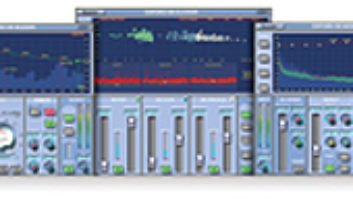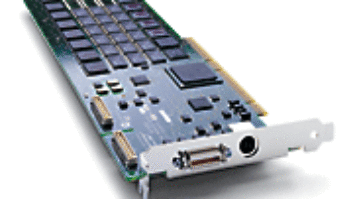If you were working in a recording studio back in the ’70s, then there were probably many sessions that made you wish for a little black box that could magically handle nondestructive editing, time compression/expansion and pitch correction. But back then, these were just pipe dreams. Well, fast-forward to 2001. Here we are, and black boxes such as Soundscape’s R.Ed digital audio workstation actually do exist. This box — like others in its category — offers a host of features we wished upon a star for, and a few we never even dared to imagine.
Soundscape has been producing PC-based DAWs since 1993 in the form of its SSHDR1. The company’s latest workstation system is the 32-track, 24-bit R.Ed recorder/editor, which offers 32 tracks of 24-bit recording at 44.1 kHz (16 tracks at 96 kHz), 28 audio input channels and 32 output channels. It runs under Windows 95/98, NT and 2000. Like Pro Tools, the computer’s processor is never used — you just use it to talk with the software interface in the little black box. The configuration we tested included 32 tracks at 24-bit/44.1 kHz, running under Windows 98, two removable IDE drives, the iBox-XLR/24 interface, the Mixtreme and Mixpander cards, and a Mackie HUI interface. The unit was easy to set up; just a few cords to plug in here and there, and we were up and running. And, despite a run-of-the-mill printed manual, there was never a need to call tech support for help. That’s always a good sign!
STORAGE IS KEY
R.Ed consists of a two-rackspace box housing two built-in, hot-swappable IDE drives — a huge plus. Not long ago, IDE drives were non-viable in a professional setting, because they weren’t A/V-rated (a drive that doesn’t have a cooling cycle and can write and read continuously without overheating). A/V drives, while SCSI-based, were always super-expensive. IDE drives, while much cheaper — half the price of an SCSI drive — were traditionally a lot slower than their A/V-rated cousins. This is no longer true. Soundscape has embraced the IDE format. This is one thing that sets R.Ed apart from its competitors. (Other hard disk systems do not yet recommend the IDE format in favor of SCSI Ultra-Wide hot-swappable drives.) The R.Ed supports two fixed and two removable IDE drives per unit with a maximum limit of 137 GB per disk. (Figure on purchasing a 30GB IDE drive for about $150.)
In this small 2U rack, you get an incredibly useful amount of storage internally via the IDE drives, meaning you don’t have to bother with external SCSI drives. Kudos to Soundscape for saving the studio owner a few bucks here.
R.Ed differs from many DAWs in design philosophy and packaging. The R.Ed consists of a PC card and black box, including storage and a few channels of I/O. LTC and video sync are an optional package. When you purchase Pro Tools, for example, you get a CD-ROM of software and a PCI card — no little black box. To round out the system, you must purchase converters to provide audio I/O, external SCSI drives and a USD (Universal Slave Driver) for sync work. The Pro Tools side of the menu is filled with a la carte options, while Soundscape prefers the combo platter, blue-plate special approach (although there is certainly no lack of upgrade and expansion possibilities for R.Ed).
FORMATS AND I/O
The second component in the R.Ed system is the iBox 8-XLR/24. In Pro Tools land, it’s equal to the 888 interface. This is where you get audio from the rest of the world into your computer. Each iBox 8-XLR/24 adds eight inputs and outputs. You can, of course, chain multiple boxes together.
Soundscape’s iBox 8-XLR/24 communicates via the TDIF standard, 8-in/8-out on one 25-pin connector. It’s the same format used by Tascam’s entire family of digital recorders, so digital consoles from Yamaha, Mackie, Spirit and Panasonic easily connect to R.Ed via the TDIF port.
AES/EBU and S/PDIF (two channels in and four out) are provided for connecting DAT players and other digital toys. Sync ports include superclock, wordclock and MIDI. An optional Sync AV card ($649) handles video sync and LTC SMPTE operations for post work.
The entire system is balanced by the host controller card that you install into an ISA slot on your PC. In the absence of an available ISA slot, users can purchase a parallel port adapter. Low-cost PCI EPP parallel cards are also available for applications where the printer port is used by a sequencer dongle.
PLETHORA OF PLUG-INS
R.Ed includes an amazing complement of DSP plug-ins, including a Time Module for time stretch, pitch shift and sample rate conversion; an Audio Toolbox fielding chorus/flanging, dynamics, delay and dither; Wave Mechanics Reverb; TC Works Reverb; TC Works Dynamizer to handle multiband expansion, compression, limiting and several levels of mastering tasks; Synchro Arts VocALign for vocal overdubs and dialog replacement; Dolby Surround Pro Logic; Cedar Declick; Cedar Dehiss; Arboretum Hyperprism Multi-FX bundle; Aphex Aural Exciter and big Bottom Pro; Apogee UV22 Mastertools; and Sonic Timeworks Compressor-X.
The selection of plug-ins is impressive, and they all worked well. However, the graphic layout was a bit underwhelming. But once you’re used to the look and feel of the plug-ins, you’re good to go. Just remember that your selection of plug-ins will greatly depend on third-party developers and how quick they are to churn out product for R.Ed.
THE SOFTWARE INTERFACE
If there’s a drawback of the R.Ed, it’s the software interface. The system is based on Version 2 of Soundscape’s earlier foray into DAWs: the SSHDR1-Plus. As you would expect, here you can handle nondestructive editing functions such as Cut, Copy, Move, Trim, Slip, Normalize and Fades in real time. You can work with any controller that you prefer: mouse, trackball, pen/tablet or other device. Punch-in/-out recording, editing on-the-fly and multiple levels of undo/redo are provided, along with 999 nameable markers that can be dropped on-the-fly and used for looping and auditioning edits.
The software seemed to have been designed by a computer programmer and not a recording engineer. The interface is not overly intuitive, and many of the icons don’t provide graphical clues as to what they actually do. There are no pop-up icon helpers to differentiate between the tools, although tool help is available by double-clicking in the toolbar. Viewing a waveform onscreen should be a no-brainer, and we wondered why Waveform mode is optional.
[Editor’s note: In the latest software, V. 3.3, Waveform view is now automatic.]
The ease-of-use factor tripped us up several times while doing a voice-over session for a 30-second TV promo. Our basic modus operandi was this: load in music strips from a DAT, select sound effects from a CD library, record and edit the voice-over talent, and then mix using a variety of plug-ins. While most of the session was smooth — and sounded great — the interface made the session arduous. Each task required several steps to choose your action before selecting what you want to apply the action to. These additional steps impede your speed, even while carrying out simple cut and paste tasks.
[Editor’s note: According to Soundscape, this is addressed via a new Multi-Function Tool function in V. 3.3. Here, the mouse pointer turns into an icon for fast access to any user-defined edit function when the pointer is moved over an audio segment. Also, customizeable function keys offer access to frequently needed tools or commands.]
We were impressed with the R.Ed system’s lack of latency — there was no delay between the initial sound source and the sound at the outputs. The inherent sound quality was also a bonus, making R.Ed viable for all professional situations. And, drum roll please, the system didn’t crash once — a comforting thought when you run sessions with clients underfoot.
ENDGAME
There are five factors that will put R.Ed on your “A” list:
- The cost: It’s less expensive than many competing products.
- R.Ed sounds good.
- It’s super stable.
- The IDE drives. For the reasons stated earlier in this article, IDE makes a lot of sense for the post pro environment.
- Onboard DSP enhanced by the power of the Mixpander card. Soundscape has put a lot of effort into the DSP options, and the quality and diversity from third-party vendors is outstanding.
Soundscape’s R.Ed does everything any other DAW editor does — and some functions are carried out with much more panache. But, until you’re accustomed to using the system and take advantage of setting up the function keys, shortcuts, etc. — navigation will be slow. Our wish list for the next version of R.Ed also includes a improved manual and better implementation for the HUI.
Soundscape is in investment mode right now, so these improvements may be in the works. Considerable R&D is being done by the company, and a line of complementary products for R.Ed is offered, including the very powerful Mixtreme PCI card that provides 16 channels of 24-bit digital input and output via two 8-channel TDIF ports. It also has full 24-bit digital mixing and real-time DSP effects plug-ins. In addition, if you’re concerned about DSP power, have no fear. The Mixpander card takes some of the load from the Mixtreme, allowing for fast and reliable DSP processing, as well as integration of any PC-hosted software running ASIO, MME or GSIF (Gigasampler/Studio) drivers. As R.Ed doesn’t tax on the PC’s processing, running GigaStudio or software synths should be no problem.
Another check in the “Pro” column is Soundscape’s commitment to creating products that are backward-compatible. If you’ve already got the company’s SSHDR1-Plus, then check out the company’s trade-up program. And, finally, the price: about $5,700 for the standard 32-track system.
Soundscape Digital Technology Inc., 4435 McGrath Street, Suite 308, Ventura, CA 93003; 805/658-7375; fax: 805/658-6395; www.soundscape-digital.com.
Leonard Hospidor is a post engineer based in New York City. Andrea Rotondo Hospidor is an engineer and freelance writer.


